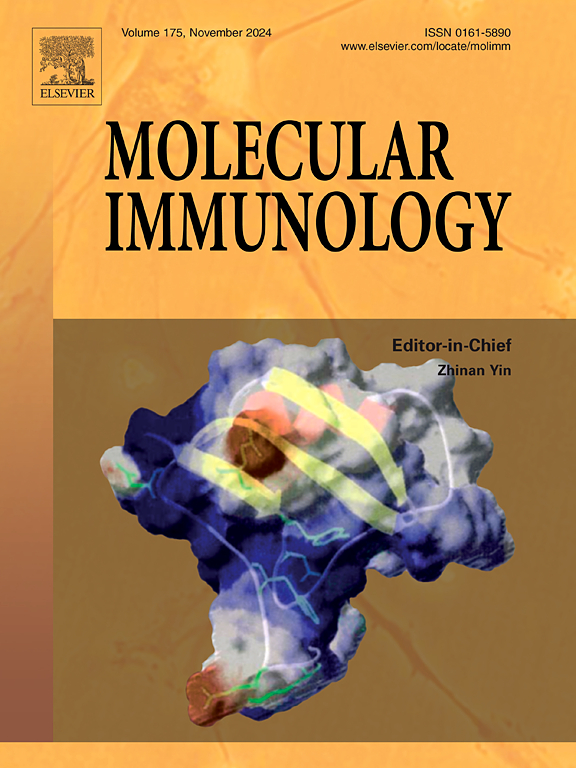缺氧NSCLC细胞中装载snhg16的细胞外囊泡驱动M2巨噬细胞极化以增强肿瘤侵袭性
IF 3
3区 医学
Q2 BIOCHEMISTRY & MOLECULAR BIOLOGY
引用次数: 0
摘要
缺氧通过调节肿瘤免疫微环境(TIME)在非小细胞肺癌(NSCLC)的进展中起关键作用。肿瘤相关巨噬细胞(tam)是TIME的重要组成部分,可在缺氧条件下调节。不幸的是,缺氧在时间内调节tam影响NSCLC进展的分子机制尚未完全描述。本研究证实,缺氧刺激的NSCLC细胞分泌的细胞外囊泡(EVs)具有高表达小核核RNA宿主基因16 (SNHG16)的特征,含SNHG16的EVs (SNHG16-EVs)通过传递SNHG16协同促进NSCLC细胞的细胞增殖、上皮-间质转化(EMT)和肿瘤干细胞(CSC)特性,并诱导THP-1细胞中巨噬细胞的m2极化。值得注意的是,m2极化巨噬细胞能够通过分泌肿瘤启动因子,包括白细胞介素-10 (IL-10)、转化生长因子β (TGF-β)和血管内皮源性生长因子(VEGF),增强NSCLC细胞的肿瘤侵袭性。在机制上,我们发现SNHG16海绵miR-132-3p通过竞争内源性RNA (ceRNA)依赖机制的方式正向调节其下游靶标激酶家族成员5 A (KIF5A)。救援实验证实,snhg16 - ev诱导的NSCLC进展和THP-1细胞的M2极化均可通过过表达miR-132-3p和沉默KIF5A逆转。总的来说,缺氧刺激的NSCLC细胞通过调节下游miR-132-3p /KIF5A轴,将含有snhg16的ev转移到NSCLC中,促进肿瘤侵袭性和m2极化巨噬细胞,本研究证实靶向snhg16 - ev可能是通过调节TME阻碍NSCLC进展的一种新策略。本文章由计算机程序翻译,如有差异,请以英文原文为准。
SNHG16-loaded extracellular vesicles from hypoxic NSCLC cells drive M2 macrophage polarization to enhance cancer aggressiveness
Hypoxia plays a critical role in regulating the progression of non-small cell lung cancer (NSCLC) by modulating the tumor immune microenvironment (TIME). Tumor-associated macrophages (TAMs), important components of TIME, can be regulated by hypoxic conditions. Unfortunately, the molecular mechanisms by which hypoxia regulates TAMs in TIME to affect NSCLC progression has not been fully delineated. The present study evidenced that hypoxia-stimulated NSCLC cells secreted extracellular vesicles (EVs) were featured with highly expressed small nucleolar RNA host gene 16 (SNHG16), and SNHG16-containing EVs (SNHG16-EVs) synergistically promoted cell proliferation, epithelial-mesenchymal transition (EMT), and cancer stem cell (CSC) properties in NSCLC cells, and induced M2-polarization of macrophages in THP-1 cells through delivering SNHG16. Notably, M2-polarized macrophages were capable of enhancing cancer aggressiveness in NSCLC cells through secreting tumor-initiating cytokines, including interleukin-10 (IL-10), transforming growth factor β (TGF-β), and vascular endothelial-derived growth factor (VEGF). Mechanistically, it was found that SNHG16 sponged miR-132–3p to positively regulate its downstream target, kinesin family member 5 A (KIF5A), via a competing endogenous RNA (ceRNA) mechanism-dependent manner. Rescue experiments confirmed that SNHG16-EVs induced NSCLC progression and M2 polarization of THP-1 cells were all reversed by overexpressing miR-132–3p and silencing KIF5A. Collectively, hypoxia-stimulated NSCLC cells transferred SNHG16-containing EVs to promote cancer aggressiveness and M2-polarized macrophages in NSCLC through modulating the downstream miR-132–3p/KIF5A axis, and this study verified that targeting SNHG16-EVs may be a novel strategy to hamper NSCLC progression via modulating TME.
求助全文
通过发布文献求助,成功后即可免费获取论文全文。
去求助
来源期刊

Molecular immunology
医学-免疫学
CiteScore
6.90
自引率
2.80%
发文量
324
审稿时长
50 days
期刊介绍:
Molecular Immunology publishes original articles, reviews and commentaries on all areas of immunology, with a particular focus on description of cellular, biochemical or genetic mechanisms underlying immunological phenomena. Studies on all model organisms, from invertebrates to humans, are suitable. Examples include, but are not restricted to:
Infection, autoimmunity, transplantation, immunodeficiencies, inflammation and tumor immunology
Mechanisms of induction, regulation and termination of innate and adaptive immunity
Intercellular communication, cooperation and regulation
Intracellular mechanisms of immunity (endocytosis, protein trafficking, pathogen recognition, antigen presentation, etc)
Mechanisms of action of the cells and molecules of the immune system
Structural analysis
Development of the immune system
Comparative immunology and evolution of the immune system
"Omics" studies and bioinformatics
Vaccines, biotechnology and therapeutic manipulation of the immune system (therapeutic antibodies, cytokines, cellular therapies, etc)
Technical developments.
 求助内容:
求助内容: 应助结果提醒方式:
应助结果提醒方式:


